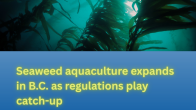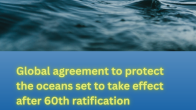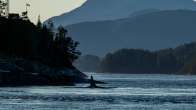Killer Whale Critical Habitat

Few marine creatures are more iconic of British Columbia’s coast than the killer whale. Historically, these magnificent whales were targeted as competitors for the salmon fisheries, to the point where n 1961 Fisheries and Oceans Canada installed a machine gun at Seymour Narrows just north of Campbell River as part of a planned cull that was called off when the whales shifted their foraging pattern. Today, thousands of people from around the world visit the home waters of these whales just to catch a glimpse of them, and to study their unique family structure and their complex ‘dialects’.
Although killer whales are now mainly a welcome sight to coastal residents, and are protected from direct harm under Canada’s Fisheries Act, they still face many risks.
- Prey Availability – Resident killer whales live almost exclusively on salmon and show a strong preference for Chinook, which is much better nutritional value for the whales than other species of salmon. Many runs of Chinook have seen poor returns in recent years, meaning these whales must now travel much farther to find their ideal food. Because of this, fisheries plans must now take the whales requirements into account when deciding how much Chinook commercial and recreational fisheries can take.
- Pollution – Many forms of chemical pollution pose a danger to killer whales. Exposure to oil spills, large and small, can cause serious harm to whales and their ability to successfully reproduce. Although the whales may live as long as 80 years, their life expectancy is lowered by pollution from humans, particularly polychlorinated biphenyls (PCBs) and dichlorodiphenyltrichloroethane (DDT). Orcas are at the apex of the food web and the toxins in their prey accumulate in the whales’ bodies, lowering their reproductive rates and damaging their immune systems. Additional micro-pollutants such as pharmaceuticals and plastic particles, which are present in very small concentrations in the environment, can still cause harmful effects in whales.
- Disturbance and Noise Pollution – On top of all the other threats the whales face, is increasing vessel traffic areas used by killer whales. Higher traffic means a higher risk that vessels will come into contact with whales, as well as creating a nosier underwater environment. Underwater noise affects orcas’ survival because they hunt using echo location, sending out clicking sounds that bounce off their prey and other objects. Well-meaning whale watchers, can also cause unintended stress in the whales by getting too close or blocking the whales path while they are feeding.
In 1999, the resident killer whales in the north Pacific were listed as ‘Threatened’ under Canada’s Species At Risk Act (SARA) because of their declining population and shortage of prey. The northern resident killer whales, which live in the waters around northern Vancouver Island and the Central Coast, have kept this listing. The southern population, which live around southern Vancouver Island and Puget Sound, were listed separately as ‘Endangered’ under SARA in 2001.
In 2008, Fisheries and Oceans Canada declared Johnstone Strait critical habitat for the northern resident killer whale, for which they issued a Protection Order in 2010. Several conservation groups (Ecojustice, Greenpeace, Georgia Strait Alliance, Sierra Club B.C. and Raincoast Conservation Foundation) won a lawsuit against Fisheries and Oceans Canada for failing to adequately protect critical habitat of B.C.’s resident killer whales, as the protection order ignored the biological aspects of critical habitat, including water quality, noise pollution and food supply.
Living Oceans Society is now working with the groups listed above to ensure that these important factors are properly addressed for the northern resident killer whale habitat. We are also working to increase protection for their habitat through the provincial and federal planning processes and a network of marine protected areas (MPAs). We are also working to keep the coastal waters on which these whale rely free of the oil and accoustic pollution that increased tanker traffic would bring with it.






